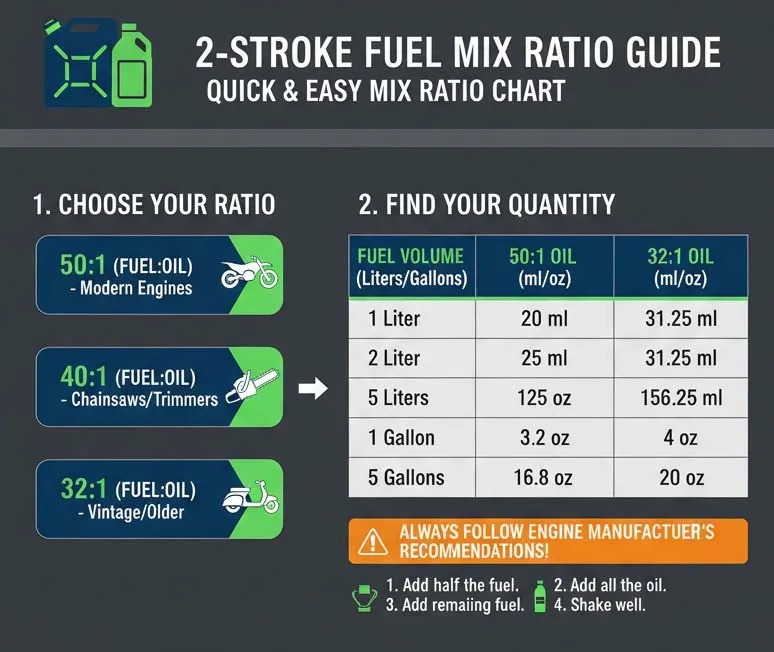
The selection of 2 stroke oil is one of the most significant actions, which you can perform to make sure that your engine continues to run smoothly, efficiently, and in the long run. The 2 stroke engine is also left to burn the oil along with the fuel unlike the 4-stroke engine that utilizes a separate oil reservoir. That is, the choice of oil directly affects lubrication, internal cleanliness, temperature of the engine, the amount of smoke generated, and performance.
This guide will assist you to know what to look for in choosing 2 stroke oil, its importance, and how to prevent the frequent mistakes which result in poor performance or engine damages. Other riders resort to a 2 stroke oil mixing calculator in order not to commit the mistake of ratios during the mixing of the fuel, yet the quality of the oil itself has the largest influence on the protection of the engine despite the mixing of the fuel.
Why Oil Quality Matters in 2 Stroke Engines
The oil is burned in conjunction with fuel therefore has to be specially made to:
In case of using low quality oil, the following issues might arise:
| Problem | Cause | Effect |
| Carbon buildup | Oil doesn’t burn clean | Loss of engine power |
| Spark plug fouling | Too much residue | Hard starting & rough idle |
| Overheating | Poor lubrication | Increased engine wear |
| Blue smoke exhaust | Oil not formulated properly | Waste of fuel and oil |
Good oil ensures cleaner combustion, which means better performance and less maintenance.
Understanding oil types helps you match your engine’s needs:
This is the oldest and most conventional one which is composed of refined petroleum.
This is a combination of mineral and synthetic base oils.
This type balances cost and performance, making it ideal for most everyday users.
Manufactured out of chemically engineered molecules to the maximum level of performance.
Fully synthetic oil is more expensive, but it can last much longer and also save on repair. expenses.
To ensure you're buying quality oil, always check the certification labels:
| Certification | Meaning | Best Grade to Look For |
| API TC | Indicates oil suitable for air-cooled 2 stroke engines | Choose API TC or higher |
| JASO | Smoke & cleanliness standard from Japan | JASO FC or FD for cleaner burning |
| ISO | European quality and protection standard | ISO-L-EGD is ideal |
If a bottle shows JASO FD + API TC, it typically indicates high-quality oil with clean burning properties.
Not all 2 stroke engines have the same demand. Consider how and where the engine operates:
| Engine Type | Oil Requirement |
| Motorcycles & Scooters | Needs cleaner-burning oil to prevent plug fouling |
| Chainsaws & Tools | Requires high-temperature protection due to heavy load bursts |
| Outboard Marine Engines | Needs low-smoke oil that’s environmentally safe around water |
Choosing based on usage prevents overworking your engine with the wrong formulation.
Various engines have various fuel to oil ratios. The ratio defines the proportion of oil, which will be mixed in every liter of fuel. As an illustration, a 40:1 fuel mix chart indicates the ratios of these works as far as certain engine requirements are concerned - never trust your manual without checking it first.
| Mistake | Result |
| Buying only by price | Cheap oil burns dirty and increases repairs |
| Mixing different brands | May cause inconsistency in lubrication |
| Ignoring certification labels | Risk of poor-quality oil |
| Using car engine oil | NEVER suitable; can destroy a 2 stroke engine |
Always stick to oil made specifically for 2 stroke engines.
In case of any of these, change to a better grade of oil and wipe or change the plug.
Choose synthetic if:
Although synthetic oil is more expensive per liter, it tends to end up being cheaper in terms of repair costs and replacement of pistons in the long run.
The 2 stroke oil does not only come down to cost and brand name; it is about wearing out your engine, heat and the build up of carbon. So, by taking into account the type of oil, rating of certification, selecting according to the usage of the engine and keeping the right ratio between fuel and oil, you will be able to have a longer, smoother and more efficient engine.
Even a minimal consideration of the quality of oil to-day will save costly repair to-morrow. You can trust your engine to serve you well, perform better and be more reliable, you just have to take your time, read the labels and make a good choice. For the oil quantity you can use a remix calculator for exact oil measurement.

This post has been published by the admin of our website, responsible for content management, quality checks, and providing valuable information to our users.


